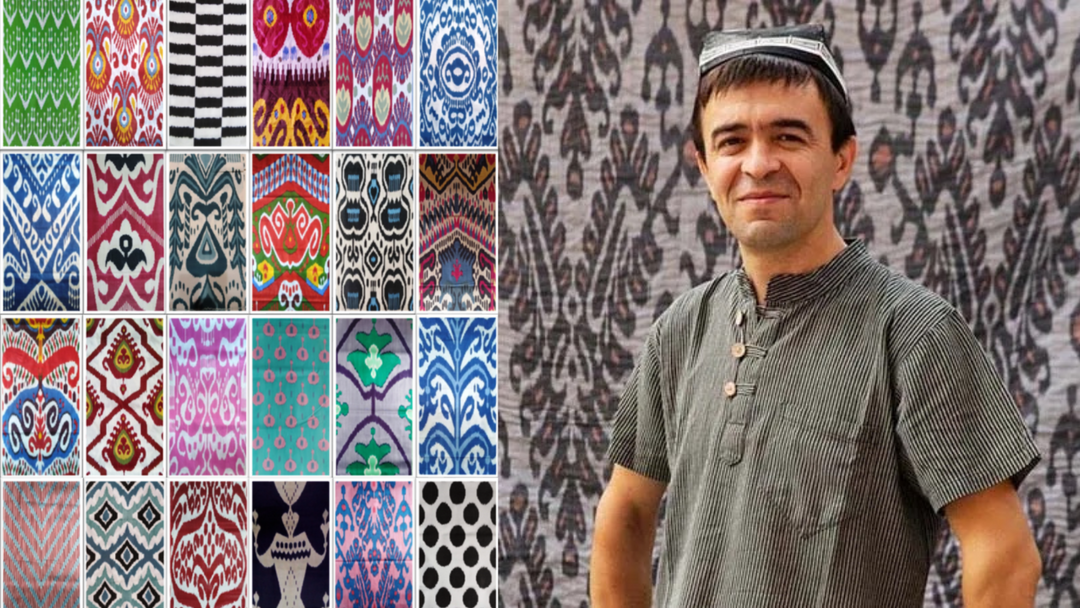At HoonArts, we believe that by partnering with our master artists in Central Asia AND our Western buyers, we can help transform the world through the traditional arts of the Silk Road. Last week, I discussed some of the global problems generated by the dominant “fast fashion” model of production, which is driven by constantly changing trends and cheap overseas production. (If you missed last week’s blog, Part 1 in our series on Transforming OUR World through the Silk Road Arts, check it out here.) Today, I want to discuss why the traditional arts matter.
Central Asia's traditional arts, being deeply rooted in the region's history and heritage, serve as a cultural anchor for the artisans. In a rapidly changing world, where globalization and modernization are reshaping societies, the traditional arts provide a sense of identity and continuity, not only for the artisans but also for the general population. By preserving and practicing these age-old crafts, artisans and the larger society maintain a connection with their ancestors and cultural roots, fostering a strong sense of belonging and pride.
It is not surprising that preservation of the artistic and cultural heritage represented by the traditional arts of the region is a priority for the artists, in light of the intense efforts of Moscow to destroy that heritage during the Soviet period. As late as the mid-1980’s (only a few years before the collapse of the Soviet Union and independence), the government was still sending artists to prison for practicing their art. Moscow viewed private artistic practice as contrary to the principles of a centrally planned economy and ownership of the means of production by the state. For example in Margilan, Uzbekistan, over 70 ikat weaving masters were sent to prison for 5 years for weaving in secret, having been ordered to destroy their weaving equipment and looms.
One of my most fascinating experiences during the HoonArts tour to Central Asia last fall was seeing young engaged or wedding couples having their wedding photos and videos taken at famous historical/cultural sites–another sign that art and cultural history serves as a source of identity and continuity. The photo below was a snapshot of a young couple at the Sarazm archeological site in Tajikistan, who walked slowly and thoughtfully around the site while their professional videographer captured their stroll. We saw similar wedding parties at some of the major architectural sites in Samarkand.

What does that “traditional cultural heritage” look like for the three countries where HoonArts works? Central Asia has been at the cross-roads of history for thousands of years, with a constant ebb and flow of armies, traders and explorers from across the Eurasian continent and beyond. The “Great Silk Road” crisscrossed Central Asia as early as 300 BC, as shown in the following two maps of the Silk Road. The arts traveled these same routes, moving in both directions.


The timeline below is focused on Tajikistan, but most of the periods of invasion and control apply equally to large swaths of modern-day Uzbekistan and Kyrgyzstan.

The modern countries of Central Asia did not exist as separate countries until independence in 1991. The historical reality is that the areas now known as Tajikistan, Uzbekistan and Kyrgyzstan were administered as part of the same geo-political units for much of recorded history, with constantly shifting boundaries at the edges. The following map reflects the unified administration of large parts of Central Asia in the 1300’s in the “chagatai khanate.”

Although the modern countries of Central Asia were separate “Soviet Republics” during the Soviet period, the Soviet divisions did not reflect ethnic or tribal boundaries. In many ways, Moscow simply drew boundaries to “divide and conquer.” For example, the cities of Bukhara and Samarkand, located in modern Uzbekistan, have a dominant Tajik cultural and ethnic history, and many (most?) locals speak Tajik as their mother tongue. Central Asia has always been an extremely diverse population because of its position as a major crossroads between East and West.
I’ve had some very interesting conversations with suzani embroidery masters from Uzbekistan and Tajikistan about this issue. For example, Munira Akilova of Tajikistan loves to point out that the famous "Uzbek" cities of Bukhara and Samarkand are actually Tajik in ethnic and cultural identity, though she tends not to bring that up when in the company of citizens of modern Uzbekistan. There are some Tajiks who argue that Bukhara and Samarkand should have been included within the boundaries of Tajikistan. This summer, when I hosted a Bukharan suzani master (who speaks Tajik as his mother tongue) at my home, he opined quite enthusiastically that it was pointless for the Tajiks to focus on one period of history rather than to acknowledge the reality that both countries share a long common history.
Nevertheless, there are ethnic artistic traditions that have become associated with the Tajiks, the Uzbeks and the Kyrgyz people, rooted in their own cultural and ethnic history. Each group (and the corresponding modern nation) has come to “anchor” its artistic traditions in one period, despite being washed by the constant ebb and flow of other cultures throughout millennia. (Does this sound familiar? In modern America, the social and political battles over what is authentically “American” is the source of much of our current divisive discourse.)
The Cultural Anchors
• Tajikistan: The Samanid Empire (Sunni Iranian) (819-999)
The Samanid Empire was a Persianate Sunni empire of Iranian origin, centered in Khorasan and Transoxiana (between Western and Central Asia). At its greatest extent it encompassed Persia and Central Asia. The Samanid Empire saw the creation of a Persianate culture and identity that brought Iranian speech and traditions into the fold of the Islamic world. The Samanids promoted the arts, giving rise to the advancement of science and literature, and thus attracted scholars such as Rudaki, Ferdowsi, and Avicenna. While under Samanid control, Bukhara was a rival to Baghdad in its glory.
• Uzbekistan: Timurid Empire (1370-1506)
The Timurid Empire was a culturally Persianate Turco-Mongol empire that dominated Greater Iran in the early 15th century, comprising modern-day Iran, Iraq, Afghanistan, much of Central Asia, the South Caucasus, as well as parts of modern Pakistan, North India and Turkey. The empire was culturally hybrid, combining Turko-Mongolian and Persianate influences. The empire was founded by Timur (known in the West as Tamerlane), a warlord of Turco-Mongol lineage, who established the empire between 1370 and his death in 1405. He envisioned himself as the great restorer of the Mongol Empire of Genghis Khan, regarding himself as Genghis's heir. Timur continued vigorous trade relations with Ming China and the Golden Horde. The empire led to the Timurid Renaissance, particularly during the reign of astronomer and mathematician Ulugh Begh. The golden age of Persian painting began during the reign of the Timurids. The great Timurid architecture of Bukhara and Samarkand is the pinnacle of Islamic art in Central Asia.

• Kyrgyzstan: Epic of Manas:
Manas is based on Bars Bek (b. 637-d. 711), first “khagan” of the Kyrgyz Khaganate, and his son and grandson. The Epic recounts events coinciding with the history of the region in the 9th century, primarily the interaction of the nomadic Kyrgyz people of the forest with other Turkic and Chinese people and the unification of the warring Kyrgyz tribes. To learn more about the Epic of Manas, check out our earlier blog post on the subject here.
These “anchors” have become a design focus of particular traditional arts in the region.
Embroidery
In suzani embroidery (both in Tajikistan and Uzbekistan), the traditional patterns emphasize Persian floral and botanic elements, as well as astronomical patterns. Zoroastrian symbols (like the lamp, which resembles a teapot) often appear in suzani embroidery. There are variations in pattern design and color combinations, however, that generally tend to correspond to the river valleys running through the region, without regard to national boundaries.
For example, the red, white and black color combination, with larger bold embroidery patterns, are characteristic of the Zerafshan river valley, which crosses both Tajikistan and Uzbekistan.


Wood Carving
These floral and botanic patterns also dominate in Tajik woodcarving, whether used in large-scale architectural elements or small scale items like combs.


Ikat Weaving
Silk weaving in Margilan, Uzbekistan dates back to the 10th century. From the 12th century onwards, abrbandi (the local Uzbek word for “ikat”, meaning “to tie a cloud”) robes became highly esteemed icons of status and were worn by both Central Asian men and women during special festivities. They were also used as dowries, to wrap newborn babies and were gifted to honor guests and foreign emissaries in courts – their quality reflecting the status of the recipient. Wealthy Central Asian merchants also adorned themselves with up to ten layers of abrbandi robes, displaying their wealth and status in a most flamboyant manner.
The rich colours of abrabandi traditional ikats were obtained from all-natural resources; the color yellow derived from saffron, gold from the dried rind of pomegranates, red from crushed cochineal insects, brown from walnut husk and blue from the indigo plant imported from the Indian subcontinent. However, the recipes for such dyes were closely held secrets of Jewish merchants and artisans, who lived in Central Asia’s oasis cities of Bukhara, Tashkent and Samarkand, particularly during the Timurid period.

Felting in Kyrgyzstan
The most popular traditional art still practiced in Kyrgyzstan is felting, in many forms. As a nomadic people, the Kyrgyz couldn’t carry traditional weaving equipment with them. Instead, they focused their textile production on felting from the wool of their sheep herds. They carried their elaborate felted yurt homes and carpets, both decorated with traditional patterns, with them on their nomadic journeys. Felted slippers continue to be part of everyone’s wardrobe. Each pattern has a story and meaning behind it that was passed from one generation to the next.




Art Also Serves as a Connector
Additionally, traditional arts often involve communities coming together to create and enjoy these crafts. The process of producing artisan products becomes a social and communal activity, strengthening social bonds and fostering a sense of community among the artisans. This community support can be a vital aspect in challenging times, providing emotional and economic support to the artisans. Cultural festivals featuring the traditional arts have also become a wonderful source of community identity, connection and pride in the Silk Road countries of Central Asia.

And, last but certainly not least, the traditional arts serve as a connector between East and West, captivating and engaging Western travelers and buyers. Art requires no common language, but it serves as a wonderful “hook” to capture attention and allow the conversation to begin!

Thank you for joining me on this whirlwind journey through the history and culture of the some of the traditional arts of Tajikistan, Uzbekistan and Kyrgyzstan. I hope you have a better sense of the how these arts serve as a cultural anchor for artists and communities along the modern Silk Road, as a connector within the community, and as a bridge between East and West.
Next week, we’ll return with Part 3 of this series, which will look more closely at the effort to balance authenticity and modernization in the Silk Road arts.







This is a very helpful article to try to untangle and understand the cultural history of Central Asia. It’s so complex but now I get it, at least better than I did. Thanks for writing all of this!
Leave a comment